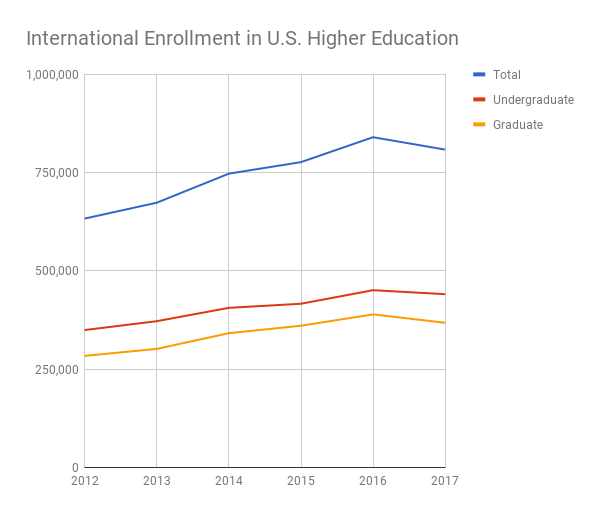
Being an international student is an incredible experience and can broaden opportunities.
But renowned international study destinations in higher education are experiencing a regression in the number of applicants for the first time in years. The number of international students in the U.S. fell by 2.2 percent at the undergraduate level and 5.5 percent at the graduate level in 2017.
In the UK, universities blame Brexit for a fall in the number of EU applications – 4.4% less in 2017 than the previous year. This reversed an on-going trend of annual rises since 2012 – meaning Brexit may provide an adequate explanation.
[fusion_builder_row_inner][fusion_builder_column_inner type=”1_3″ layout=”1_3″ spacing=”” center_content=”no” hover_type=”none” link=”” min_height=”” hide_on_mobile=”small-visibility,medium-visibility,large-visibility” class=”” id=”” background_color=”” background_image=”” background_position=”left top” background_repeat=”no-repeat” border_size=”0″ border_color=”” border_style=”solid” padding_top=”” padding_right=”” padding_bottom=”” padding_left=”” dimension_margin=”” animation_type=”” animation_direction=”left” animation_speed=”0.3″ animation_offset=”” last=”no” border_position=”all”]
–
Although this, of course, presents a catalyst only applicable for the UK, the US experienced a paralleled trend in their sudden fall for international enrolment between 2016 and 2017.
In fact, overall, the universities in the survey reported an average decline in new international enrollments of 7 percent.
[/fusion_builder_column_inner][fusion_builder_column_inner type=”2_3″ layout=”2_3″ spacing=”” center_content=”no” hover_type=”none” link=”” min_height=”” hide_on_mobile=”small-visibility,medium-visibility,large-visibility” class=”” id=”” background_color=”” background_image=”” background_position=”left top” background_repeat=”no-repeat” border_size=”0″ border_color=”” border_style=”solid” padding_top=”” padding_right=”” padding_bottom=”” padding_left=”” dimension_margin=”” animation_type=”” animation_direction=”left” animation_speed=”0.3″ animation_offset=”” last=”no” border_position=”all”] [/fusion_builder_column_inner][/fusion_builder_row_inner]
[/fusion_builder_column_inner][/fusion_builder_row_inner]
While some of the world’s leading nations for international student applicants have plummeted, what can be done internally by universities and business schools to irregulate this trend and restore consistent, annual increases?
Help students to learn the domestic language
A big challenge for international students concerns learning the native language of their chosen study destination to a level they’d be happy with. In the UK and US, international students undergo tests to assess their capabilities, and some receive additional help with the language after they arrive.
Whether this is a fair reflection of their understanding of that given native language is another story. To familiarize with a foreign language is difficult enough, but to pick up on dialect, regional idioms and metaphors are likely to be nonsensical without an explanation.
If you couple this with frequent assessment, and even presentations, it presents additional pressures to perform at a similar level to native speakers. Words of encouragement, reassurance or better yet, tailored assistance, can go a long way in combating this and giving international students the vote of confidence needed.
Cultural engagement
Leading on from a better understanding of the native language, it is important for students to have social and cultural knowledge of the country they’re now studying in. Terms such as ‘lost in translation’ and ‘culture shock’ are applicable here and can negatively impact social and academic experiences at university.
To overcome this, it could be useful for lecturers to incorporate discussion on native culture into their classes. This can be done through the lecturer themselves, or by making a conscious effort to invoke peer interaction. Having a better understanding of political or economic issues, for example, can go a long way to improving international student’s understanding of their new surroundings.
More social activity
There is a need to develop an effective communication between students. The creation of friendships and social networks helps provide students with an identity in foreign surroundings. The UK, US, and Australia are just a few examples of popular study destinations who have their own variation of a ‘freshers week’, with the aim to boost student integration and ease the ‘settling in’ process.
Focus on the first week could be problematic, however. Efforts to maintain peer interaction should run all year round to minimize the risk of international students feeling isolated and without a social outlet. Having more extracurricular activities, clubs and societies can help with this.
Diverse study methods
The frequence of independent study compared to time spent in class can be one of the main differences that an international student experiences studying in another country. They may have great difficulty making the transition required in a considerably small space of time.
If they are now required to learn independently as opposed to spending more time in class, they may struggle to prioritize the correct the information – not to mention in an unfamiliar language.
This same language barrier can present issues with group work – another aspect of higher education that is prominent compared with lower levels of study. Institution’s need to consider the social context of student adjustment in order to make their academic experience that bit easier.
How are student motivations influenced by the region they come from? Find out in our ‘What Matters to International Students?’ industry report.



